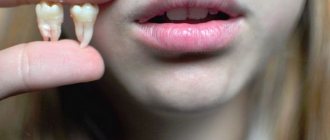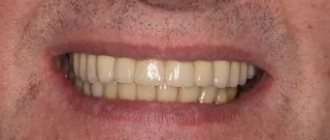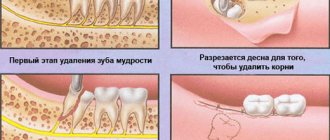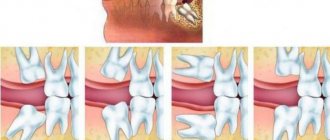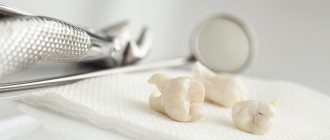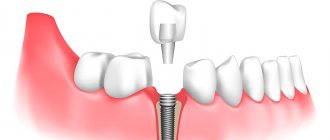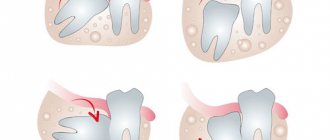Indications and contraindications Pros Cons Implantation process Alternatives
Teeth transplantation from your own dentition is a procedure that is used as an alternative to implantation. Every person has teeth that are not involved in the chewing process, do not affect the bite and do not perform any important functions. These are wisdom teeth. They are the ones who most often become donor teeth. But not always.
There are teeth that grow outside the arch, spoil the smile, and provoke inflammation. You can get rid of the problem through orthodontic treatment: installing splints, plates, braces. There are times when the only option is deletion. Then the tooth has a chance to benefit its owner. It can be transplanted to a place where a tooth is lost or planned to be pulled out.
Another source of donors for transplantation is supernumerary teeth. Some people grow double teeth. Such units are direct candidates for removal. At the same time, they can be beneficial by replacing a sick or lost brother.
Replacing an artificial root
Sometimes it happens that the patient’s body rejects the implant. Most often this happens due to the fact that the body perceives the implant material as a foreign body. In this case, the dentist has no choice but to remove the implant. Fortunately, nowadays it is possible to reuse an implant of a different design. Reimplantation is necessary in the following cases:
- implant rejection;
- dentist mistakes;
- use of a defective implant;
- the patient’s failure to comply with the dentist’s recommendations;
- deterioration of general health;
- expired implant.
Separately, it is worth mentioning jaw injuries. Sometimes even a minor injury causes the artificial structure to begin to wobble. In this case, you have to resort to reimplantation.
At the same time, a worn-out crown can be replaced by installing it on the previous artificial root. The same applies to replacing the abutment - the connecting link between the crown and the implant.
How much does it cost to replace a damaged implant or tooth?
Reimplantation of your own tooth in Moscow, including its primary fixation, depending on the clinic and the experience of the specialist, will average from 2,500 rubles. Therapeutic preparation is assessed separately.
If the problem with the implant occurred due to the patient’s fault, you will have to pay from 5,000 rubles for removal, installation of a new one will cost from 15,000 rubles.
The final price will depend on:
- complexity and number of additional manipulations;
- region of location and status of the clinic;
- qualifications of the attending physician;
- implant models.
How is the old implant removed?
First of all, it is worth saying that if any problems arise with the implants, then you should only contact the clinic where they were installed. This is important, including for financial reasons. The savings are explained by the fact that a new design calculation is not required.
Most implant manufacturers usually guarantee their impeccable service for 5-7 years. Reputable manufacturers provide such a guarantee for decades and even for life. Of course, the cost of such implants is very high, if not unaffordable for most of our fellow citizens. In addition, reimplantation is not considered the fault of the manufacturer, and therefore has to be paid for again. Only some clinics do it for free in order to raise their authority.
This dental operation is performed in the following sequence:
- disinfection of the oral cavity;
- crown removal;
- removal of the implant from the jawbone.
After this, the patient will have to undergo examinations to determine the cause of implant rejection. After doctors determine the cause, the treatment stage begins.
Do I need to insert a tooth myself?
In case of incomplete dislocation, the crown that protrudes strongly from the gums at the scene of the incident can be carefully inserted into place without applying significant effort. This will prevent complete tooth loss, the likelihood of which is quite high. But you shouldn’t touch a knocked-out baby tooth; it’s better to quickly go to the dentist to identify possible damage to soft tissue and bone.
If a piece of a tooth breaks off, you should rinse your mouth with clean water, try to find the fragment and rush to see a qualified doctor.
Oral hygiene after implant removal
For several hours after removal of the implant, you should avoid eating altogether. You should absolutely not drink alcohol or smoke for two days. This can cause inflammation not only in the gums, but also in the jawbone. During the first day after surgery, you should not brush your teeth or even rinse your mouth with elixir solutions. Then you can brush your teeth only with a soft toothbrush. In this case, irrigators and flosses should not be used at the site of implant removal.
Advantages and disadvantages
The main advantage of this method is the ability to save a tooth that has been damaged. At the same time, the dentition retains its natural appearance, and the person does not feel any discomfort after complete engraftment.
Also among the advantages are:
- the ability to perform replantation in one step over a short amount of time;
- high probability of engraftment, even if it was outside the oral cavity for up to 48 hours;
- maintaining the functionality of the implanted tooth for up to twenty years.
Another advantage is the short recovery period, which often passes without much discomfort or pain symptoms.
The main disadvantage of replantation is the likelihood that the tooth will not heal. This result is possible if the tooth was stored in incorrect conditions before the operation, or the doctor made certain professional mistakes.
Other disadvantages of the procedure include:
- the presence of a large number of contraindications that may interfere with the operation;
- If there is significant damage to the crown, replantation may not be possible.
Patients often consider the disadvantage of having to adhere to a very strict diet and oral care recommendations during the rehabilitation period.
Sequence of re-implantation
The first stage is examination and treatment.
At the second stage, the surgical operation is performed directly. At this time, the supporting part of the implant is installed in the bone bed, which in most cases is first increased in size using a special cutter.
The third stage of re-implantation begins one to two weeks after root installation. At this time, an incision is made on the mucous membrane to expose the upper part of the implant. This is necessary to install a gum former or an abutment made of titanium. The dentist begins the fourth stage only after three to six months. At this time, a dental crown is installed.
How does natural tooth transplantation work?
The operation is carefully prepared, the patient must undergo examination, diagnosis and at the time of the intervention not suffer from acute diseases.
A tooth can be transplanted either into the socket of a newly extracted tooth, or a place for it can be created artificially using dental instruments. It is important that as little time as possible passes between the removal of the donor and its transplantation. Otherwise, the tissues that normally hold the tooth in the socket - the periodontal ligaments - will die. The most common procedure is wisdom tooth transplantation. Removing it can be a problem in itself. The roots of such teeth are complex, often intertwined. Carrying out an operation without damage requires great skill.
- Preparation
. Sanitation of the oral cavity and professional cleaning are necessary to eliminate the possibility of infection. - Diagnostics
. A computed tomography scan and measurements are required. - Making a 3D model
. This stage is carried out only in clinics with appropriate equipment. In dentistry it is simpler; the tooth is adjusted by eye during transplantation. - Preparing the bed
. If the tooth has been lost previously, the bed is formed artificially. If removal occurs during replantation surgery, then the hole formed in the gum is used. - Trying on a 3D model
. Based on the scan, an exact copy of the donor is made. It is used during the surgical stage to form a bed or adjust it. - Removing a donor
. It is performed under anesthesia. Requires special care, because you need to preserve all the tissue. - Installation
of the donor, its
fixation
with a splint. - Bite removal
. The chewing tubercles are polished so that the tooth does not come into contact with the antagonist and does not participate in chewing (temporary measure). - Recovery period
. It lasts differently for everyone, it takes about 2-3 weeks. - Depulpation
.
Removal of the nerve (pulp). During transplantation, the pulp receives damage that leads to death. If it is not removed, decay products can cause inflammation and the work will be in vain, the tooth will not heal. After removal, calcium preparations are introduced into the cavity and a temporary filling is placed. another 2 weeks,
the canals are filled. - Bite restoration
. The surface relief, previously polished, is restored with composite materials. - Prosthetics
. An inlay or crown is made to correct any discrepancies and protect the tooth.
Indications and contraindications for natural tooth reimplantation
This type of operation is the exception rather than common practice. It is impossible when there is atrophy of a section of the jaw bone, as well as when adjacent crowns are closed.
When is reimplantation indicated:
- loss due to crown injury;
- dislocation when removing molars;
- jaw bone fracture;
- root perforation;
- canal obstruction;
- injury when removing adjacent crowns.
Contraindications for reimplantation:
- extensive caries;
- the presence of diseases of the jaw bone tissue in acute form;
- gum disease;
- severe curvature of the roots;
- cardiovascular diseases;
- mental illness;
- acute infectious disease;
- oncological neoplasms;
- acute radiation sickness.
Preparing for surgery
Before proceeding directly to the transplantation process itself, the dentist examines the patient’s oral cavity. The problematic tooth is thoroughly cleaned of tartar and plaque to eliminate the risk of infection and tissue contamination.
As part of the preparation, it is also necessary to cure all existing manifestations of caries on the teeth that are in contact with the tooth to be restored. The replanted tooth must meet all the requirements for normal survival:
- well preserved enamel;
- absence of pronounced carious process;
- smooth roots without noticeable curvatures.
If the tooth socket is inflamed, then the oral cavity is treated with antibacterial agents, and all inflammatory foci are eliminated. During this time, the tooth is placed in an antiseptic solution. The pulp is examined and, if necessary, removed, after which the dental canals are filled.
Which tooth can be reimplanted?
A lost tooth can be implanted only if it meets certain conditions. These are:
- integrity of the tooth crown;
- straight tooth roots;
- proper storage of a lost tooth (up to two days in a sodium chloride solution at a temperature of 37 - 40 degrees).
The success of this operation greatly depends on the professionalism of the dentist. This is especially true when the tooth is not lost, but is severely loosened due to injury. Such a tooth sometimes has to be carefully removed and then put back in place.
How is the transplant done?
The best option for a successful transplant is a tooth germ surrounded by a follicle in which roots have not yet formed. The dental follicle or dental sac consists of cells and fibers that surround the tooth germ.
Tooth transplantation - stages:
- diagnostic - obtaining x-rays, performing computed tomography;
- removal of the affected tooth;
- washing the hole with a solution of an antiseptic and antibiotic - if necessary, leave a tampon in it if removal and transplantation are carried out on different days;
- extracting a healthy tooth or its germ from the socket;
- implanting it in place of a removed or lost tooth;
- fixation with a splint;
- suturing.
After an average of 25 days, the splints are removed. During this time, the tooth should take root in its new location. This technology completely restores the beauty of the smile, chewing functions and helps prevent the development of bite defects, since the teeth can shift towards the defect, filling the empty space.
Advantages of reimplantation
Perhaps it’s worth repeating and saying that reimplantation can only be successful if you consult a doctor in a timely manner. As for the advantages, these include:
- preservation of natural teeth;
- the operation is performed once;
- the possibility of implanting a lost tooth after two days;
- quick implantation;
- long service life (5 - 20 years);
- the cost of the operation is low.
It is also worth considering as an advantage the fact that when a natural tooth is implanted, the overall architecture of the dentition is not disturbed. Inflammation during implantation is practically not observed. Neighboring teeth do not move, and degeneration of the jaw bone area does not occur.
What it is?
Dental transplantation or transplantation is an operation in which a dental surgeon transplants an existing tooth germ or the tooth itself to the place where it is missing. Most often, this is autotransplantation of teeth - that is, the patient’s own teeth or their rudiments are used to restore a gap in the dentition.
The transplanted tooth germ develops in the new socket in the same way as its neighbors in their native sockets. Its root system grows into the jaw bone, so the nutrition of the tooth is no different from the nutrition of its neighbors. This ensures the reliability of the transplant result. As a result, such a tooth fully replaces the lost one. This technique is used for:
- congenital absence of a tooth, when the formation of a tooth germ has not occurred;
- tooth loss due to injury;
- removal due to deep caries;
- tooth extraction on the recommendation of an orthodontist, since some defects in tooth development can lead to malocclusion.
In addition to transplantation, there is a method of tooth reimplantation. The fundamental difference between them is that during reimplantation, the doctor first removes the tooth and then implants it in the same socket. Most often, this technique is used to eliminate a source of infection that cannot be eliminated by conservative therapy. A common feature of reimplantation and tooth transplantation is that it is important to preserve the integrity of the tooth and its roots.
Sequence of the operation
Reimplantation of a natural tooth is always done under local anesthesia and in several stages. Their order is as follows:
- anesthesia;
- careful extraction of the tooth while maintaining the size of the socket;
- keeping the extracted tooth in a sodium chloride solution;
- treatment of the extracted tooth, if necessary, and removal of plaque;
- cleaning the socket and gum pocket;
- disinfection of the socket and gum pocket;
- placing the tooth in its original place.
Complete implantation of the tooth usually occurs on the 20th day after surgery.
General overview
Technically, replantation is a set of medical procedures that result in the return of a damaged tooth to the alveolar socket. This technique is implemented quite rarely, which is due to the need for a number of mandatory conditions to coincide. The basis for choosing this method of dental treatment is the diagnosis of dislocation, chronic periodontitis, which negatively affects the condition of bone tissue, as well as the occurrence of problems with single-rooted frontal incisors that form the smile area.
Reimplantation of a natural tooth with splinting
In some cases, the installed tooth must be strengthened. This technique is called splinting. Its essence is to install a special thin plate or aramid thread on the inner surface of the tooth crown and on two adjacent teeth. In addition, splinting can be done using caps. In the latter case, the patient will have to wear them for a month, or even a month and a half.
Splinting in most cases is used for dislocated teeth, as well as single-rooted ones. Multi-rooted teeth are installed without splinting. The splinted tooth is excluded from the bite by slightly grinding down the tubercles on its upper part.
Recommendations after tooth replantation
Unfortunately, in most cases it is impossible to predict how the engraftment process will go. It is very important to follow all doctor’s instructions during this period. In addition to maintaining your usual oral hygiene, be sure to take a course of prescribed antibiotics.
It is also recommended to completely eliminate any mechanical impact and pressure on the jaw for up to six months, that is, you should be careful about eating hard and solid foods.
Regular visits to the dentist and routine X-ray examinations will allow you to monitor the process of tooth healing and prevent the development of serious complications.
Postoperative period
During the first two hours after tooth reimplantation, you should under no circumstances eat or drink. Then for 24 hours you should stop cleaning and rinsing your mouth, spitting, smoking and drinking alcohol. In addition, physical activity should be avoided during this time. Under no circumstances should you eat solid food for three to four days after surgery. It is advisable not to eat anything other than thin first courses. During this time, some patients may experience tissue swelling. In such a situation, you have to apply compresses and take antibiotics and sometimes painkillers.
A prerequisite is to visit the dentist two days after the operation.
Preparatory measures
First, you should visit your dentist. To decide whether dental surgery (replantation) can be performed in this case, the doctor carefully examines the condition of the socket, the oral cavity and the prolapsed unit. For a complete clinical picture, an x-ray will be required. If no contraindications are identified, the oral cavity is prepared for the upcoming manipulation:
- Healing caries, if there is one in the mouth.
- Professional teeth cleaning.
- Tartar removal.
- Thorough antiseptic treatment.
What could be the consequences?
If the implantation process proceeds normally, it is usually completed 4 to 6 weeks after surgery. The process of tooth implantation itself can proceed in different ways. It depends on what preliminary measures the dentist had to apply
During periodontal preparation, the periosteum of the alveoli and the remains of periodontal tissue are completely preserved.
With periodontal fibrotic preparation, the alveolus and tooth roots are only partially preserved. During osteoid preparation, the periosteum of the alveoli and periodontium is completely removed.
The fastest way to implant a natural tooth is with the periodontal preparation method. On the contrary, this process occurs most slowly with the osteoid method.
After reimplantation, intact and completely healthy teeth last the longest. If the operation is not performed accurately, it may happen that the tooth roots begin to dissolve, causing the tooth to become very loose and have to be removed.
Kinds
Traditional orthopedic classification distinguishes two treatment formats:
- Vital restoration - used in situations where the crown and pulp remain unharmed, is not accompanied by canal filling, and involves splinting the row using wire or styracrylic tape.
- Devital restoration is a more complex procedure that combines extraction of the problematic tooth, removal of root processes and filling of the canals with composite material. The element is reintegrated into the row after processing is completed.
The choice in favor of one of these methods depends on the results of the examination conducted at the preliminary stage.
Indications
In dental cases that cannot be treated surgically, the problematic tooth is removed from the socket, the pathology is eliminated and the unit is installed in place - replantation is carried out. In addition to a cyst located in a hard-to-reach place, indications for surgery include:
– dislocation due to injury;
– perforation of the root part;
– lack of possibility for filling the surface along the length of the tubules in dentin or for resection of the apex;
– neighboring units that are difficult to remove.
What to do to prevent the installation of implants from causing harm
To avoid complications during dental implantation, you need to cooperate with the implantologist and strictly adhere to the recommendations. It is important to familiarize yourself with some of the nuances of the procedure in order to recognize the danger.
Follow your doctor's recommendations
Expert advice is aimed at speeding up the implant healing process. But the main task is to protect a person from complications. Recommendations from experts that must be followed strictly:
- Take prescribed medications (strictly on time, in the indicated doses, for the prescribed period).
- Irrigate the oral cavity with antiseptic solutions (do this regularly for the required period to prevent tissue infection).
- Monitor (by the visual condition of the gums or the patient’s own feelings) the process of implant integration, consult a doctor if alarming symptoms occur.
- Care for the oral cavity according to the prescribed scheme (do not skip hygiene treatments, do it conscientiously).
- Quit smoking for at least 2 weeks before and after surgery (bad habit slows down healing).
Choose quality implants
Cheap artificial roots have not undergone sufficient clinical testing, and it is impossible to predict safety and stability during use. The surface of the material may contain tiny foreign particles that interfere with osseointegration, which increases the risk of complications.
In our Center for dental implantation, implants from Nobel Biocare are used, which were developed based on the results of clinical research
over 50 years.
Nobel Biocare advantages:
- Survival rate 99,3%.
- The microstructure of the TI-Unite implant surface imitates root dentin; the artificial root takes root within 2 weeks .
- Protection against counterfeiting thanks to proprietary numbering of Nobel Biocare implants.
- Lifetime warranty.
Find out the cost
The price of implantation includes the cost of materials, preparation and operation of expensive equipment, and the services of several specialists on whom the result depends. Taking into account acceptable costs, dental implantation cannot cost 10-20 thousand rubles.
Complications during implant installation
Installing an implant involves introducing a titanium root into the bone. The classic protocol for the procedure is as follows:
- The doctor makes an incision and carefully peels away the gum to access the bone.
- Creates a hole of the required diameter in the bone tissue and screws in the implant.
- Places a titanium plug on it until the tissue heals completely.
- Places stitches. The tissues grow together in 1-2 weeks.
Bleeding may occur during surgery. The reason may be the inept actions of the implantologist (which is very rare), hypertension or bleeding disorders in a patient who did not warn the doctor about the disease. Moderate bleeding from the intervention area for 2-3 hours is normal. Heavy bleeding for more than 3 hours immediately after the intervention indicates a complication. Minor exudation is possible for up to 7 days.
What contraindications to implantation can lead to possible complications?
Restrictions can be absolute or relative. The first ones say that implantation is impossible. Ignoring will lead to complications for the patient. Absolute contraindications include:
- chronic diseases in the stage of decompensation;
- serious bleeding disorders;
- mental disorders.
With relative restrictions, implantation is carried out after treatment and improvement of the patient’s condition. These include:
- ARVI;
- chronic infections;
- suffered a heart attack or stroke;
- period of pregnancy and breastfeeding;
- risk of bacteremia (against the background of rheumatism, endocarditis, as well as in patients with prosthetic heart valves);
- exacerbation of chronic diseases;
- drug treatment that reduces the regenerative capacity of tissues.
For prosthetics
The final stage of dental implantation involves the installation of dentures. To do this, the doctor:
- removes the gum former;
- installs the abutment (plays the role of an adapter from the intraosseous element to the crown);
- attaches a crown or orthopedic structure created from previously taken impressions of the patient’s jaw.
The orthopedic design must suit the patient taking into account the position of the implants. Errors can result in incomplete adhesion of the prosthetic attachments and abutments, leading to loosening of the implants. Inconsistencies between them lead to incorrect distribution of the load during operation, which also leads to damage to the structure and is fraught with rejection.
The coordinated work of the orthopedist and implantologist during preparation is extremely important.
In our Center, implant installation is safe and completely painless
Painful sensations can be considered a complication during installation. But anesthesia is carried out first, the patient should not feel anything. Increased pain is possible, but the discomfort goes away after an additional dose of anesthetic is administered. The patient should not endure the pain; if it intensifies, the doctor must be informed immediately. We offer implantation in medicated sleep under sedation , when the patient is in a relaxed, comfortable state of half-sleep and does not feel any pain.
Levin Dmitry Valerievich
Chief physician, Ph.D.
Prices in our Center are natural and final
The cost of the surgical stage of installing the Nobel implant is from 60,000 rubles. Includes the cost of the implant, its installation, anesthesia, bone reconstruction, installation of formers, as well as pre- and post-operative examinations.
Levin Dmitry Valerievich
Chief physician, Ph.D.
Contact experienced doctors
The level of qualification of a specialist is indicated by:
- practical experience working with implants;
- portfolio of work and client reviews;
- evidence of regular completion of advanced training courses;
- reputation and popularity of the clinic.
Our Center employs highly qualified doctors and employees of Moscow universities. They undergo internships in the USA and Germany and regularly take advanced training courses. Our implantologists know the nuances of all time-tested implantation protocols and the latest innovations. We will try to help and not disappoint you.
What are the dangers of implanting upper teeth?
When implanting teeth in the upper jaw, the bottom of the maxillary sinus is sometimes damaged. The complication occurs due to incorrect determination of the height of the alveolar process or excessive pressure on the instrument. This complication is extremely rare, as a preliminary computed tomography (CT) scan is performed to determine the height of the jaw bone and select the correct implant. If the bone size is not enough to install an implant of the required size, bone tissue augmentation is performed - sinus lift.


